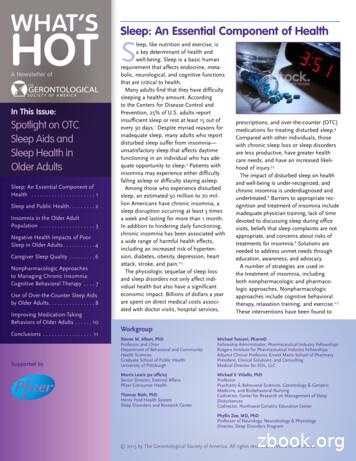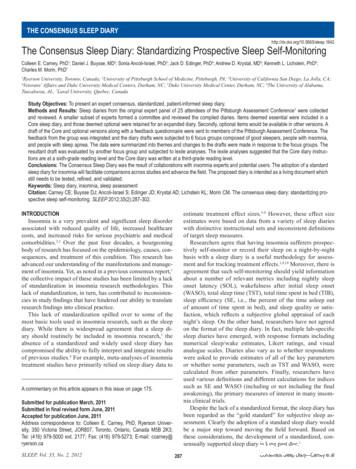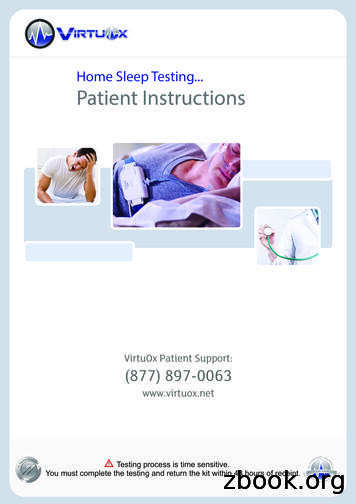New Guideline - Sleep
New GuidelineFebruary 2017The AASM has published a new clinical practice guideline for the pharmacologic treatment ofchronic insomnia in adults. These new recommendations are based on a systematic review of theliterature on individual drugs commonly used to treat insomnia, and were developed using theGRADE methodology. The recommendations in this guideline define principles of practice thatshould meet the needs of most adult patients, when pharmacologic treatment of chronic insomniais indicated. The clinical practice guideline is an essential update to the clinical guidelinedocument:Sateia MJ, Buysse DJ, Krystal AD, Neubauer DN, Heald JL. Clinical practice guideline for thepharmacologic treatment of chronic insomnia in adults: an American Academy of SleepMedicine clinical practice guideline. J Clin Sleep Med. 2017;13(2):307–349.
Special ArticleClinical Guideline for the Evaluation and Management of Chronic Insomnia in AdultsSharon Schutte-Rodin, M.D.1; Lauren Broch, Ph.D.2; Daniel Buysse, M.D.3; Cynthia Dorsey, Ph.D.4; Michael Sateia, M.D.5Penn Sleep Centers, Philadelphia, PA; 2Good Samaritan Hospital, Suffern, NY; 3UPMC Sleep Medicine Center, Pittsburgh, PA; 4SleepHealthCenters, Bedford, MA; 5Dartmouth-Hitchcock Medical Center, Lebanon, NH1Insomnia is the most prevalent sleep disorder in the general population, and is commonly encountered in medical practices. Insomnia isdefined as the subjective perception of difficulty with sleep initiation,duration, consolidation, or quality that occurs despite adequate opportunity for sleep, and that results in some form of daytime impairment.1Insomnia may present with a variety of specific complaints and etiologies, making the evaluation and management of chronic insomniademanding on a clinician’s time. The purpose of this clinical guidelineis to provide clinicians with a practical framework for the assessmentand disease management of chronic adult insomnia, using existingevidence-based insomnia practice parameters where available, andconsensus-based recommendations to bridge areas where such parameters do not exist. Unless otherwise stated, “insomnia” refers tochronic insomnia, which is present for at least a month, as opposed toacute or transient insomnia, which may last days to weeks.Citation: Schutte-Rodin S; Broch L; Buysse D; Dorsey C; Sateia M.Clinical guideline for the evaluation and management of chronic insomnia in adults. J Clin Sleep Med 2008;4(5):487-504.SUMMARY RECOMMENDATIONSquestionnaires, at-home sleep logs, symptom checklists,psychological screening tests, and bed partner interviews.(Guideline) At minimum, the patient should complete: (1) A general medical/psychiatric questionnaire to identify comorbid disorders (2) The Epworth Sleepiness Scale orother sleepiness assessment to identify sleepy patientsand comorbid disorders of sleepiness (3) A two-weeksleep log to identify general patterns of sleep-waketimes and day-to-day variability. (Consensus) Sleep diary data should be collected prior to and during the course of active treatment and in the case ofrelapse or reevaluation in the long-term. (Consensus) Additional assessment instruments that may aid in thebaseline evaluation and outcomes follow-up of patients with chronic insomnia include measures of subjective sleep quality, psychological assessment scales,daytime function, quality of life, and dysfunctionalbeliefs and attitudes. (Consensus) Physical and mental status examination may provide important information regarding comorbid conditions anddifferential diagnosis. (Standard) Polysomnography and daytime multiple sleep latency testing (MSLT) are not indicated in the routine evaluation ofchronic insomnia, including insomnia due to psychiatric orneuropsychiatric disorders. (Standard) Polysomnography is indicated when there is reasonable clinical suspicion of breathing (sleep apnea) ormovement disorders, when initial diagnosis is uncertain, treatment fails (behavioral or pharmacologic), orprecipitous arousals occur with violent or injuriousbehavior. (Guideline)General: Insomnia is an important public health problem that requires accurate diagnosis and effective treatment. (Standard) An insomnia diagnosis requires associated daytime dysfunction in addition to appropriate insomnia symptomatology. (ICSD-2 definition)Evaluation: Insomnia is primarily diagnosed by clinical evaluationthrough a thorough sleep history and detailed medical, substance, and psychiatric history. (Standard) The sleep history should cover specific insomnia complaints, pre-sleep conditions, sleep-wake patterns, other sleep-related symptoms, and daytime consequences.(Consensus) The history helps to establish the type and evolutionof insomnia, perpetuating factors, and identification ofcomorbid medical, substance, and/or psychiatric conditions. (Consensus) Instruments which are helpful in the evaluation and differential diagnosis of insomnia include self-administeredSubmitted for publication July, 2008Accepted for publication July, 2008Address correspondence to: Sharon L. Schutte-Rodin, M.D., Penn SleepCenters, University of Pennsylvania Health System, 3624 Market St., 2ndFloor, Philadelphia, PA 19104; Tel: (215) 615-3669; Fax: (215) 615-4835;E-mail: rodins@hphs.upenn.eduJournal of Clinical Sleep Medicine, Vol. 4, No. 5, 2008487
S Schutte-Rodin, L Broch, D Buysse et al Actigraphy is indicated as a method to characterize circadian rhythm patterns or sleep disturbances in individualswith insomnia, including insomnia associated with depression. (Option) Other laboratory testing (e.g., blood, radiographic) is not indicated for the routine evaluation of chronic insomnia unlessthere is suspicion for comorbid disorders. (Consensus) Differential Diagnosis: The presence of one insomnia disorder does not excludeother disorders, as multiple primary and comorbid insomnia disorders may coexist. (Consensus) Treatment Goals/Treatment Outcomes: Regardless of the therapy type, primary treatment goals are:(1) to improve sleep quality and quantity and (2) to improveinsomnia related daytime impairments. (Consensus) Other specific outcome indicators for sleep generally include measures of wake time after sleep onset (WASO),sleep onset latency (SOL), number of awakenings, sleeptime or sleep efficiency, formation of a positive and clearassociation between the bed and sleeping, and improvement of sleep related psychological distress. (Consensus) Sleep diary data should be collected prior to and duringthe course of active treatment and in the case of relapse orreevaluation in the long term (every 6 months). (Consensus) In addition to clinical reassessment, repeated administration of questionnaires and survey instruments may be useful in assessing outcome and guiding further treatment efforts. (Consensus) Ideally, regardless of the therapy type, clinical reassessment should occur every few weeks and/or monthly untilthe insomnia appears stable or resolved, and then every 6months, as the relapse rate for insomnia is high. (Consensus) When a single treatment or combination of treatments hasbeen ineffective, other behavioral therapies, pharmacological therapies, combined therapies, or reevaluation for occult comorbid disorders should be considered. (Consensus)Pharmacological Treatment: Short-term hypnotic treatment should be supplementedwith behavioral and cognitive therapies when possible.(Consensus) When pharmacotherapy is utilized, the choice of a specificpharmacological agent within a class, should be directedby: (1) symptom pattern; (2) treatment goals; (3) past treatment responses; (4) patient preference; (5) cost; (6) availability of other treatments; (7) comorbid conditions; (8)contraindications; (9) concurrent medication interactions;and (10) side effects. (Consensus) For patients with primary insomnia (psychophysiologic,idiopathic or paradoxical ICSD-2 subtypes), when pharmacologic treatment is utilized alone or in combinationtherapy, the recommended general sequence of medicationtrials is: (Consensus) Short-intermediate acting benzodiazepine receptor agonists (BZD or newer BzRAs) or ramelteon: examples ofthese medications include zolpidem, eszopiclone, zaleplon, and temazepam Alternate short-intermediate acting BzRAs or ramelteon if the initial agent has been unsuccessful Sedating antidepressants, especially when used in conjunction with treating comorbid depression/anxiety:examples of these include trazodone, amitriptyline,doxepin, and mirtazapine Combined BzRA or ramelteon and sedating antidepressant Other sedating agents: examples include anti-epilepsymedications (gabapentin, tiagabine) and atypical antipsychotics (quetiapine and olanzapine) These medications may only be suitable for patients with comorbid insomnia who may benefitfrom the primary action of these drugs as well asfrom the sedating effect. Over-the-counter antihistamine or antihistamine/analgesictype drugs (OTC “sleep aids”) as well as herbal and nutritional substances (e.g., valerian and melatonin) are notrecommended in the treatment of chronic insomnia due tothe relative lack of efficacy and safety data. (Consensus)Psychological and Behavioral Therapies: Psychological and behavioral interventions are effectiveand recommended in the treatment of chronic primary andcomorbid (secondary) insomnia. (Standard) These treatments are effective for adults of all ages,including older adults, and chronic hypnotic users.(Standard) These treatments should be utilized as an initial intervention when appropriate and when conditions permit.(Consensus) Initial approaches to treatment should include at least onebehavioral intervention such as stimulus control therapy orrelaxation therapy, or the combination of cognitive therapy, stimulus control therapy, sleep restriction therapy withJournal of Clinical Sleep Medicine, Vol. 4, No. 5, 2008or without relaxation therapy—otherwise known as cognitive behavioral therapy for insomnia (CBT-I). (Standard)Multicomponent therapy (without cognitive therapy) iseffective and recommended therapy in the treatment ofchronic insomnia. (Guideline)Other common therapies include sleep restriction, paradoxical intention, and biofeedback therapy. (Guideline)Although all patients with chronic insomnia should adhereto rules of good sleep hygiene, there is insufficient evidenceto indicate that sleep hygiene alone is effective in the treatment of chronic insomnia. It should be used in combinationwith other therapies. (Consensus)When an initial psychological/ behavioral treatment hasbeen ineffective, other psychological/ behavioral therapies,combination CBT-I therapies, combined treatments (seebelow), or occult comorbid disorders may next be considered. (Consensus)488
Evaluation and Management of Chronic Insomnia in Adults Older approved drugs for insomnia including barbiturates,barbiturate-type drugs and chloral hydrate are not recommended for the treatment of insomnia. (Consensus) The following guidelines apply to prescription of all medications for management of chronic insomnia: (Consensus) Pharmacological treatment should be accompanied bypatient education regarding: (1) treatment goals andexpectations; (2) safety concerns; (3) potential sideeffects and drug interactions; (4) other treatment modalities (cognitive and behavioral treatments); (5) potential for dosage escalation; (6) rebound insomnia. Patients should be followed on a regular basis, everyfew weeks in the initial period of treatment when possible, to assess for effectiveness, possible side effects,and the need for ongoing medication. Efforts should be made to employ the lowest effectivemaintenance dosage of medication and to taper medication when conditions allow. Medication tapering and discontinuation are facilitated by CBT-I. Chronic hypnotic medication may be indicated for longterm use in those with severe or refractory insomnia orchronic comorbid illness. Whenever possible, patientsshould receive an adequate trial of cognitive behavioraltreatment during long-term pharmacotherapy. Long-term prescribing should be accompanied byconsistent follow-up, ongoing assessment of effectiveness, monitoring for adverse effects, andevaluation for new onset or exacerbation of existing comorbid disorders Long-term administration may be nightly, intermittent (e.g., three nights per week), or as needed.results in some form of daytime impairment. Because insomniamay present with a variety of specific complaints and contributing factors, the time required for evaluation and management ofchronic insomnia can be demanding for clinicians. The purposeof this clinical guideline is to provide clinicians with a framework for the assessment and management of chronic adult insomnia, using existing evidence-based insomnia practice parameters where available, and consensus-based recommendations tobridge areas where such parameters do not exist.METHODSThis clinical guideline includes both evidence-based and consensus-based recommendations. In the guideline summary recommendation section, each recommendation is accompanied byits level of evidence: standard, guideline, option, or consensusbased. “Standard,” “guideline,” and “option” recommendationswere incorporated from evidence-based American Academy ofSleep Medicine (AASM) practice parameter papers. “Consensus” recommendations were developed using a modified nominal group technique. The development of these recommendations and their appropriate use are described below.Evidence-Based Practice ParametersIn the development of this guideline, existing AASM practice parameter papers relevant to the evaluation and management of chronic insomnia in adults were incorporated.2-6 Thesepractice parameter papers, many of which addressed specificinsomnia-related topics rather than providing a comprehensiveclinical chronic insomnia practice guideline for clinicians, werepreviously developed via a computerized, systematic search ofthe scientific literature (for specific search terms and further details, see referenced practice parameter) and subsequent criticalreview, evaluation, and evidence-grading of all pertinent studies.7On the basis of this review the AASM Standards of PracticeCommittee developed practice parameters. Practice parameterswere designated as “Standard,” “Guideline,” or “Option” basedon the quality and amount of scientific evidence available (Table 1).Combined Treatments: The use of combined therapy (CBT-I plus medication)should be directed by (1) symptom pattern; (2) treatmentgoals; (3) past treatment responses; (4) patient preference;(5) cost; (6) availability of other treatments; (7) comorbidconditions; (8) contraindications; (9) concurrent medication interactions; and (10) side effects. (Consensus) Combined therapy shows no consistent advantage or disadvantage over CBT-I alone. Comparisons to long-termpharmacotherapy alone are not available. (Consensus)Consensus-Based RecommendationsConsensus-based recommendations were developed for thisclinical guideline to address important areas of clinical practicethat had not been the subject of a previous AASM practice parameter, or where the available empirical data was limited or inconclusive. Consensus-based recommendations reflect the sharedjudgment of the committee members and reviewers, based onthe literature and common clinical practice of topic experts, andwere developed using a modified nominal group technique. Anexpert insomnia panel was assembled by the AASM to authorthis clinical guideline. In addition to using all AASM practiceparameters and AASM Sleep publications through July 2007,the expert panel reviewed other relevant source articles from aMedline search (1999 to October 2006; all adult ages includingseniors; “insomnia and” key words relating to evaluation, testing, and treatments. Using a face-to-face meeting, voting sur-INTRODUCTIONInsomnia symptoms occur in approximately 33% to 50% ofthe adult population; insomnia symptoms with distress or impairment (general insomnia disorder) in 10% to 15%. Consistentrisk factors for insomnia include increasing age, female sex, comorbid (medical, psychiatric, sleep, and substance use) disorders, shift work, and possibly unemployment and lower socioeconomic status. “Insomnia” has been used in different contextsto refer to either a symptom or a specific disorder. In this guideline, an insomnia disorder is defined as a subjective report ofdifficulty with sleep initiation, duration, consolidation, or quality that occurs despite adequate opportunity for sleep, and thatJournal of Clinical Sleep Medicine, Vol. 4, No. 5, 2008489
S Schutte-Rodin, L Broch, D Buysse et alTable 1—AASM Levels of onThis is a generally accepted patient-care strategy that reflects a high degree of clinical certainty. The term standard generallyimplies the use of Level 1 Evidence, which directly addresses the clinical issue, or overwhelming Level 2 Evidence.This is a patient-care strategy that reflects a moderate degree of clinical certainty. The term guideline implies the use ofLevel 2 Evidence or a consensus of Level 3 Evidence.This is a patient-care strategy that reflects uncertain clinical use. The term option implies insufficient, inconclusive, or conflicting evidence or conflicting expert opinion.treatment options, resources available, and other relevant factors. The AASM expects this clinical guideline to have an impact on professional behavior and patient outcomes. It reflectsthe state of knowledge at the time of publication and will bereviewed, updated, and revised as new information becomesavailable.Table 2—Diagnostic Criteria for Insomnia (ICSD-2)A. A complaint of difficulty initiating sleep, difficulty maintaining sleep, or waking up too early, or sleep that is chronicallynonrestorative or poor in quality.B. The above sleep difficulty occurs despite adequate opportunityand circumstances for sleep.C. At least one of the following forms of daytime impairment related to the nighttime sleep difficulty is reported by the patient:1. Fatigue or malaise;2. Attention, concentration, or memory impairment;3. Social or vocational dysfunction or poor school performance;4. Mood disturbance or irritability;5. Daytime sleepiness;6. Motivation, energy, or initiative reduction;7. Proneness for errors/accidents at work or while driving;8. Tension, headaches, or gastrointestinal symptoms in response to sleep loss; and9. Concerns or worries about sleep.INSOMNIA DEFINITIONS AND EPIDEMIOLOGYInsomnia Definitionsveys, and frequent teleconference discussions, the expert panelidentified consensus areas and recommendations for those areasnot covered by AASM practice parameters. Recommendationswere generated by panel members and discussed by all. To minimize individual expert bias, the group anonymously voted andrated consensus recommendations from 1: strongly disagree to9: strongly agree. Consensus was defined when all experts rateda recommendation 8 or 9. If consensus was not evident afterthe first vote, the consensus recommendations were discussedagain, amended as appropriate, and a second anonymous votewas conducted. If consensus was not evident after the secondvote, the process was repeated until consensus was attained toinclude or exclude a recommendation.“Insomnia” has been used in different contexts to refer toeither a symptom or a specific disorder. In this guideline, aninsomnia disorder is defined as a subjective report of difficultywith sleep initiation, duration, consolidation, or quality that occurs despite adequate opportunity for sleep, and that result insome form of daytime impairment (Table 2).Except where otherwise noted, the word “insomnia” refers toan insomnia disorder in this guideline.Insomnia disorders have been categorized in various ways indifferent sleep disorder classification systems. The InternationalClassification of Sleep Disorders, 2
Evaluation and Management of Chronic Insomnia in Adults Older approved drugs for insomnia including barbiturates, barbiturate-type drugs and chloral hydrate are not recom-mended for the treatment of insomnia. (Consensus) The following guidelines apply to prescription of all medi-cations for management of chronic insomnia: (Consen-sus)
Nov 12, 2018 · 2 The Sleep in America poll was run alongside the National Sleep Foundation’s validated sleep health assessment tool, the Sleep Health Index , which has been fielded quarterly since 2016.The Index is based on measures of sleep duration, sleep quality and disordered sleep. Am
uals experience disturbed sleep at least a few nights each week12 . Research presented at SLEEP 2013, the 27th Annual Meeting of the Associated Professional Sleep Societies, LLC, addressed sleep-related topics ranging from basic sleep science, such as cell and molecular genetics, to such clinical topics as sleep disorders and sleep and aging .
Academy of Sleep Medicine, the Department of Health and Human Services, the National Sleep Foundation, and the Sleep Research Society Contract no. N01-OD-4-2139 ISBN 0-309-10111-5 (hardback) 1. Sleep disordersÑSocial aspects. 2. Sleep deprivationÑSocial aspects. 3. SleepÑSocial aspects. 4. Public health. I.
The Pittsburgh Sleep Quality Index (PSQI) 21 is a 19-item ques-tionnaire used to measure sleep quality complaints. Seven com-ponent scores assess habitual duration of sleep, nocturnal sleep disturbances, sleep latency, sleep quality, daytime dysfunction, sleep medication usage
(WASO), total sleep time (TST), total time spent in bed (TIB), sleep efficiency (SE, i.e., the percent of the time asleep out of amount of time spent in bed), and sleep quality or satis-faction, which reflects a subjective global appraisal of each night's sleep. On the other hand, researchers have not agreed on the format of the sleep diary.
then compared with that of sleep deprived non-epileptic mice along with their non-sleep deprived peers. The mice, which have sleep cycles as short as 30 - 90 seconds, are deprived of sleep for 6 hours to up to 3 weeks at a time using a physical stimulus to awaken them. This research is being used to simulate sleep apnea and chronic sleep
SLEEP NUMBER bed. You've not only made a great decision to sleep your very . My SLEEP NUMBER setting is 35 to Sleep Number 2. What's Inside Setting up your new SLEEP NUMBER bed only takes about an hour, but you'll enjoy the benefits of better sleep for years to come.
Sleep apnea occurs when you stop breathing during the night. There are three types of sleep apnea: 1) Obstructive Sleep Apnea (OSA) – upper airway collapse causing obstruction. This is the most common form of sleep apnea. 2) Central Sleep Apnea























